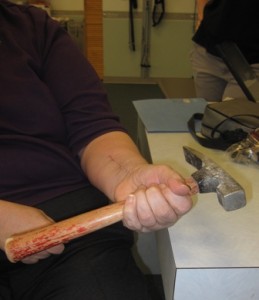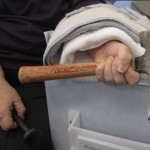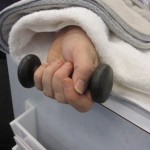Hand Therapy| Homework with a Bang
Life Long Learning| like it or not.
Six weeks ago I fell and broke my wrist. Bad news is that it hurt like #$@! The good news is it’s healing well and gave me the opportunity to learn more about therapy. Hey, I’m a glass-half-full kind of person, right?
Aaron, my son with the label of autism, started physical, occupational and speech therapy when he was a baby. In fact, therapy was one of the things we won in our due process case with the school district. So, I’ve had years of observing therapists in action. We saw Aaron go through paradigm shifts in philosophies and approaches from sensory integration, NDT (neurodevelopmental), isolated medical model therapy, multidisciplinary, transdisciplinary, interdisciplinary…and others I can’t even remember.
My broken wrist was my first hand *laugh* opportunity to actually be the patient. I am now officially “disabled” I have crossed into the “yet”.
Of course there are many differences between Aaron and my experience:
*Mine is for a short time.
*I can tell the therapist when it hurts.
*I can ask questions.
*I can understand what the therapist is trying to do.
*I can look for ways to practice the exercises.
Because of my injury, I am going to a physical therapist who specializes in Hand Therapy. Hey, this is the day of specialization. I wonder if there is a physical therapist who specializes in “thumb” therapy? Probably is.
My therapist is great. What is really interesting is for the first time I finally understand how all those stairs-to-nowhere and giant pegboards ended up in special education.
In the 70s, when children like Aaron were granted the right to education (PL. 94-142) no one knew what curriculum to use for people with severe disabilities. It made perfect sense to start with the medical model and the exercises used in the therapy rooms. In fact, in the early days, many people thought education would be the cure.
Functional Activities
As many of you know, Lou Brown from the University of Madison, WI is one of my heroes. Not only is he an amazing person and teacher, but his innovative ideas helped win Aaron’s lawsuit, and introduce a “functional curriculum” which impacted all Greater Cincinnati.
Functional Curriculum:
If the person doesn’t do it, will someone else have to do it?”
What seems like a straightforward definition is often confusing to people. For instance. When I went home and substituted a hammer was that functional learning?
If you answered “NO” you are correct.
When a hammer is just a substitute for a one pound weight, it is not a “functional skill.” (BTW I felt ridiculous watching TV and pumping the hammer with claw.)
In a medical model or scientific method experiement, you always isolate and reduce the activity to one element. Exercises are specific to one area, so they can be more easily measured.
Did this exercise strengthen the wrist?
Can the patient lift one pound?
How many degrees can the patient turn their wrist?
After a week of practicing lifting one pound weights, could the patient now lift a two pound weight?
The answer would be clean, it would be easy to chart.
Now, if I used the exercise of lifting the hammer (one pound) to hit a nail, or build a cabinet then it would be a functional exercise. But it no longer requires just one skill. It would be more difficult to chart.
Make sense?
The hammer is a tool. The one pound weight is a good therapeutic exercise for my wrist, but until I give the hammer a purpose, there is no “functional skill.”
The idea of “functional skills” is that a person would practice the exercise many times, as opposed to just a couple times a week in therapy.
For years Aaron and others climbed the stairs-to-nowhere and were swung in nets to build therapy skills.
With a “functional curriculum” Aaron learned to climb the steps in the hallway to go to lunch. He used a swing on the playground at recess. He would practice these skills several times a day. They were real, not artifical exercises done in isolation.
Here is the test:
Goal is to strengthen wrist by turning an object.
Which picture shows a “functional” task?
Does that help explain it?
Keep Climbing: Onward and Upward
All my best,
Mary
Comment:
Of course, the peppermill is the correct answer. Can you think of other “functional” activities? Did this help explain this concept.
Related Articles
Dr. Lou Brown: Busy vs. Bored, Life Space Analysis for People with Disabilities





